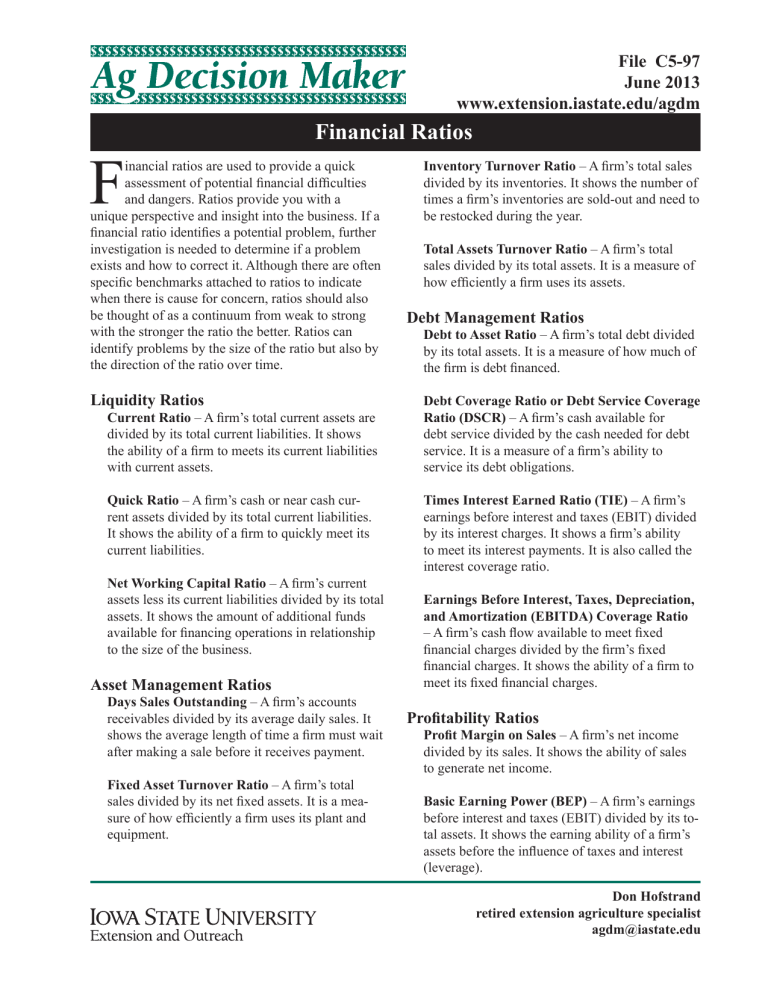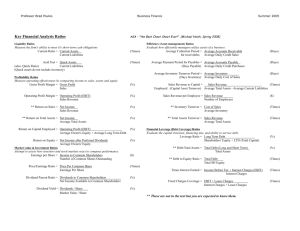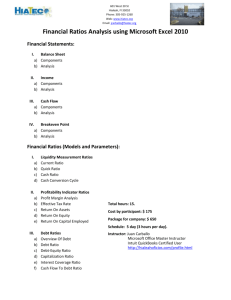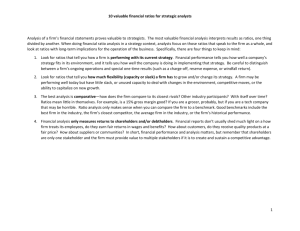Financial Ratios - Iowa State University Extension and Outreach
advertisement

File C5-97 June 2013 www.extension.iastate.edu/agdm Financial Ratios F inancial ratios are used to provide a quick assessment of potential financial difficulties and dangers. Ratios provide you with a unique perspective and insight into the business. If a financial ratio identifies a potential problem, further investigation is needed to determine if a problem exists and how to correct it. Although there are often specific benchmarks attached to ratios to indicate when there is cause for concern, ratios should also be thought of as a continuum from weak to strong with the stronger the ratio the better. Ratios can identify problems by the size of the ratio but also by the direction of the ratio over time. Liquidity Ratios Current Ratio – A firm’s total current assets are divided by its total current liabilities. It shows the ability of a firm to meets its current liabilities with current assets. Quick Ratio – A firm’s cash or near cash current assets divided by its total current liabilities. It shows the ability of a firm to quickly meet its current liabilities. Net Working Capital Ratio – A firm’s current assets less its current liabilities divided by its total assets. It shows the amount of additional funds available for financing operations in relationship to the size of the business. Asset Management Ratios Days Sales Outstanding – A firm’s accounts receivables divided by its average daily sales. It shows the average length of time a firm must wait after making a sale before it receives payment. Fixed Asset Turnover Ratio – A firm’s total sales divided by its net fixed assets. It is a measure of how efficiently a firm uses its plant and equipment. Inventory Turnover Ratio – A firm’s total sales divided by its inventories. It shows the number of times a firm’s inventories are sold-out and need to be restocked during the year. Total Assets Turnover Ratio – A firm’s total sales divided by its total assets. It is a measure of how efficiently a firm uses its assets. Debt Management Ratios Debt to Asset Ratio – A firm’s total debt divided by its total assets. It is a measure of how much of the firm is debt financed. Debt Coverage Ratio or Debt Service Coverage Ratio (DSCR) – A firm’s cash available for debt service divided by the cash needed for debt service. It is a measure of a firm’s ability to service its debt obligations. Times Interest Earned Ratio (TIE) – A firm’s earnings before interest and taxes (EBIT) divided by its interest charges. It shows a firm’s ability to meet its interest payments. It is also called the interest coverage ratio. Earnings Before Interest, Taxes, Depreciation, and Amortization (EBITDA) Coverage Ratio – A firm’s cash flow available to meet fixed financial charges divided by the firm’s fixed financial charges. It shows the ability of a firm to meet its fixed financial charges. Profitability Ratios Profit Margin on Sales – A firm’s net income divided by its sales. It shows the ability of sales to generate net income. Basic Earning Power (BEP) – A firm’s earnings before interest and taxes (EBIT) divided by its total assets. It shows the earning ability of a firm’s assets before the influence of taxes and interest (leverage). Don Hofstrand retired extension agriculture specialist agdm@iastate.edu Page 2 Return on Total Assets (ROA) – A firm’s net income divided by its total assets (both debt and equity supported assets). It shows the ability of the firm’s assets to generate net income. Interest expense is added back to net income because interest is a form of return on debt-financed assets. File C5-97 Market Value Ratios Price/Earnings Ratio (P/E) – The price per share of a firm is divided by its earnings per share. It shows the price investors are willing to pay per dollar of the firm’s earnings. Return on Equity (ROE) – A firm’s net income divided by its equity. It shows the ability of the firm’s equity to generate profits. Price/Cash Flow Ratio – The price per share of a firm divided by its cash flow per share. It shows the price investors are willing to pay per dollar of net cash flow of the firm. Return on Investment (ROI) – A firm’s net income divided by the owner’s original investment in the firm. Market-to-book value (M/B) – The market value of a firm is divided by its book value. Earnings per Share – A firm’s net income per share of stock. . . . and justice for all The U.S. Department of Agriculture (USDA) prohibits discrimination in all its programs and activities on the basis of race, color, national origin, gender, religion, age, disability, political beliefs, sexual orientation, and marital or family status. (Not all prohibited bases apply to all programs.) Many materials can be made available in alternative formats for ADA clients. To file a complaint of discrimination, write USDA, Office of Civil Rights, Room 326-W, Whitten Building, 14th and Independence Avenue, SW, Washington, DC 20250-9410 or call 202-720-5964. Issued in furtherance of Cooperative Extension work, Acts of May 8 and November 30, 1914, in cooperation with the U.S. Department of Agriculture. Cathann A. Kress, director, Cooperative Extension Service, Iowa State University of Science and Technology, Ames, Iowa.











